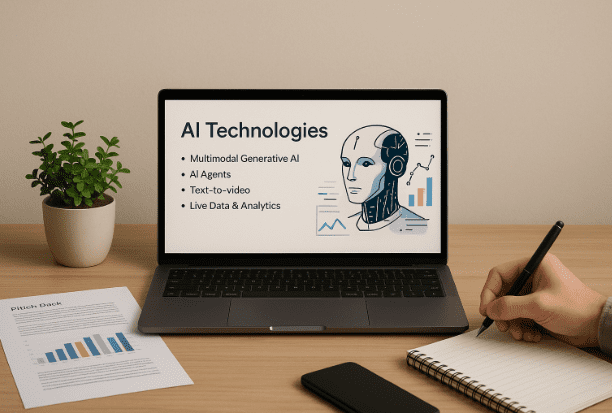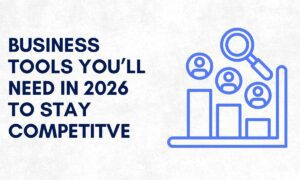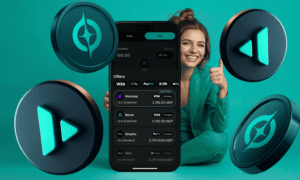Introduction
Every startup founder knows this moment: you’ve got ten minutes with investors, and your slides have to do the heavy lifting. The problem? Research shows investors usually spend less than three minutes on a deck. That’s all you get to spark interest.
Now imagine having tools that keep your slides fresh, explain your idea with a short video, and even answer tough questions in real time. By 2026, that won’t be imagination—it will be reality.
Let’s break down the four AI technologies that will reshape pitch decks in the next two years—and how you can start using them today.
1. Multimodal Generative AI: Your Slide Co-Pilot
Until recently, AI could only handle text. The new wave of multimodal models can handle text, images, charts, and even audio in one flow.
Picture this: you paste your pitch notes into an AI model, and it gives you a clean 10-slide outline, with draft visuals and simple charts built from your raw data. It’s like having a junior analyst and a design intern rolled into one.
Why it matters for founders:
- Speeds up first drafts.
- Helps simplify complex data.
- Suggests plain language edits (investors love clarity).
By 2026, expect these models to auto-design slides in your brand style—turning rough ideas into polished decks in minutes.
2. AI Agents: The Deck That Updates Itself
One of the biggest pain points with decks? They go stale fast. Markets change, competitors shift, metrics move—and suddenly your slides are out of date.
AI agents fix that. Think of them as background assistants that collect competitor updates, refresh KPI charts, and flag big swings automatically.
Example in action:
- A SaaS founder sets up an agent to check competitor pricing every Friday. Each week, it adds a one-line note to the “Market” slide.
- Another agent pulls MRR, CAC, and churn from a finance sheet at month-end and refreshes the “Traction” slide.
The result: you walk into investor meetings with a deck that feels alive, not last quarter’s news. To learn more about what data points matter most, explore our guide on key metrics every investor wants to see.
3. Text-to-Video: Show, Don’t Just Tell
Slides full of bullet points don’t stick. Investors remember what they see. That’s why text-to-video AI is a game-changer.
Tools like Sora or Runway can turn a 4-line script into a 30-second product demo video with captions and voice-over. Perfect for the “Solution” slide.
Imagine this scene: Instead of saying “Our app makes delivery faster”, you play a short clip showing the app in action, narrated by your own voice. Suddenly, investors don’t just hear the idea—they feel it.
By 2026, expect smoother, more realistic clips that make product storytelling effortless.For more tips on crafting a powerful narrative, check out our guide on how to tell a compelling story in your pitch deck.
4. Live Data & Real-Time Analytics
Every founder dreads the investor question: “What changed since last month?” If your deck is static, you scramble.
Live data slides change the game. By linking your pitch deck to a live sheet or BI tool, your charts update automatically. Some platforms now even allow chatting with your data—so when an investor asks, “Why did churn rise in July?”, you can pull up an answer on the spot.
This kind of transparency builds trust. Investors don’t just see a polished deck—they see that you know your numbers and can explain them in real time.
What Today vs. 2026 Looks Like
| Area | 2024 Reality | 2026 Potential |
| Slide drafting | Outlines + simple charts | Fully branded, auto-designed decks |
| Video | Short demo clips | Longer, seamless product stories |
| Data in slides | Linked dashboards | Interactive, chat-driven analytics |
| Automation | One-off research tasks | Continuous agents refreshing decks |
Why This Matters
The goal of these tools isn’t “flash.” It’s clarity and speed. Investors care less about design tricks and more about:
- Do you know your market?
- Can you explain it clearly?
- Do you have fresh proof points?
AI can help you deliver those answers faster and cleaner—without spending weeks tweaking slides.
For practical design help, you can also check services like pitch-deck design service, which focus on making decks both beautiful and investor-ready.Conclusion
By 2026, pitch decks won’t just be static slides. They’ll be living, visual stories—powered by AI, but shaped by you. Multimodal models will draft. Agents will refresh. Text-to-video will bring ideas to life. And live analytics will prove you know your business.
Use these tools wisely, and you won’t just keep up with investors—you’ll stay one step ahead.
FAQs
Q1. Will AI replace pitch deck designers?
No. AI drafts faster, but human designers ensure polish and trust.
Q2. Can investors tell if I used AI?
They don’t mind—what matters is clarity, accuracy, and fresh numbers.
Q3. What’s the fastest AI win for my deck?
Add one product demo video and refresh your metrics with AI charts.
Q4. How do I keep my deck from looking “AI-generated”?
Review and edit. Keep your tone natural, slides clean, and data honest.
Q5. Is live data risky in pitches?
Only if you’re unprepared. If you know your numbers, live transparency builds credibility.



































